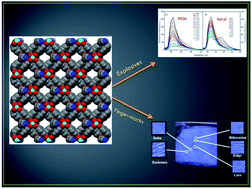A luminescent Zn-MOF for the detection of explosives and development of fingerprints†
Abstract
A luminescent 3D metal–organic framework [Zn(NDA)(AMP)] = PUC1 (where, NDA = naphthalene-2,6-dicarboxylic acid and AMP = 4-aminomethyl pyridine) was synthesized under solvothermal conditions. The synthesized 3D framework was fully characterized with the help of different analytical techniques such as SCXRD, FTIR, TGA, PXRD, SEM, BET, etc. PUC1 exhibited a strong emission peak at 371 nm when excited at 290 nm and the resulting emission was efficiently quenched in the presence of various organic explosive substances like pentaerythritol tetranitrate (PETN), 2,4,6-trinitrophenyl-N-methylnitramine (Tetryl), trinitrotoluene (TNT), 1,3,5-trinitroperhydro-1,3,5-triazine (RDX), and 1,3,5,7-tetranitro-1,3,5,7-tetrazoctane (HMX). PUC1 revealed highly sensitive and selective detection of PETN and Tetryl with high quenching constant values of 0.1 × 106 and 0.12 × 105 M−1 and low detection limits of 0.315 and 0.404 μM respectively. The strong luminescent properties of PUC1 lead to its successful application in the development of latent fingermarks on different non-porous surfaces using the powder dusting method. The accuracy and applicability of the synthesized material were determined by developing fingerprints by using secretions from eccrine and apocrine glands on a glass slide and various other surfaces, followed by dusting the surfaces. The results so obtained were found to be very accurate and promising.

- This article is part of the themed collection: Analytical Methods HOT Articles 2022


 Please wait while we load your content...
Please wait while we load your content...